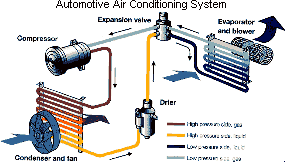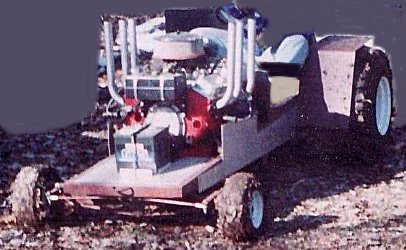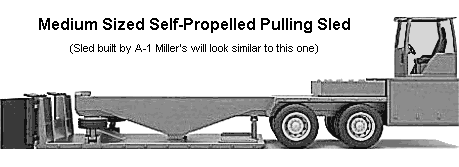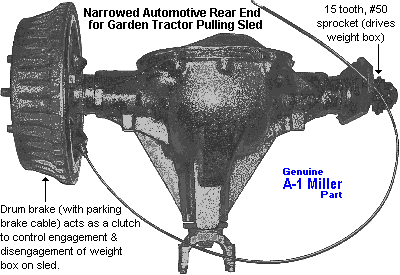A-1 Miller's Performance Enterprises
Professional Automotive Services Available in Central Missouri!
Professional Automotive Air Conditioning (A/C)
Services (Posted 7/5/24.) [Top of Page]
-
 Vacuum and recharge automotive
a/c system: $50.00 - $100.00 labor only, depending on year, make,
model and size of vehicle. Extra charge for compressor lubricating oil and
refrigerant (Freon).
Vacuum and recharge automotive
a/c system: $50.00 - $100.00 labor only, depending on year, make,
model and size of vehicle. Extra charge for compressor lubricating oil and
refrigerant (Freon).
-
Repair leaking automotive a/c system: $150.00 - $500.00 labor only,
depending on year, make, model and size of vehicle. Extra charge for installation
of new parts.
-
Prices are subject to change without notice. And remember - Perfection takes
time. If it's worth having, it's worth waiting for. It'll be money well spent.
If interested, please contact below.
Professional Old School Automotive Services
- (Posted 6/28/24.) [Top of Page]
A-1 Miller's Performance Enterprises now offers complete old school automotive
rebuilding and modifications, and car and truck repairs, modifications and
building of custom-made hot rods, street rods, motorcycle repairs. Chevrolet,
GMC, Chrysler, Ford, Harley-Davidson, etc. Prices vary depending on make,
model and year of engine, and which modifications are needed. Prices are
subject to change without notice. And remember - Perfection takes time. If
it's worth having, it's worth waiting for. It'll be money well spent.
If interested, please contact below.




Competitively Built and Nice-Appearing Small Wheel
(26-12.00x12 tires) Mini Rod Pulling Tractors (Posted 3/7/25.)
[Top of Page]
 A-1 Miller's Performance
Enterprises now offers construction of competitive small wheel (26-12.00x12
tires) mini rod pulling tractors.
A-1 Miller's Performance
Enterprises now offers construction of competitive small wheel (26-12.00x12
tires) mini rod pulling tractors.
Small wheel mini rod with 229 or 4.3 Chevy V6 engine (built to the max),
manual transmission and 8" or 9" Ford rear end. (As shown.) $15.000.
But price and details may vary depending on clubs' rules and customer's
preferences.
Prices are subject to change without notice. And remember - Perfection takes
time. If it's worth having, it's worth waiting for. It'll be money well spent.
If interested, please contact below.
Available Soon - Detailed Illustrated Plans on How
to Construct a Professional Pull-Back Garden Tractor Pulling Sled and a
Self-Propelled Garden Tractor/Small Wheel Mini Rod Pulling Sled (Weight Transfer
Machines) - (Updated 7/16/24) [Top of Page]
 FYI - I'm getting closer to
completing my sled plans. But being I have lots of work to do in my shop,
I work on designing my sled plans in my spare time. As soon as my plans with
an inventory list of parts to use and with illustrations are perfected, I'll
post the announcement in my websites. And as for prices of the pull-back
sled and self-propelled sled plans, I'm not sure yet. Make me an offer and
I'll consider it. And remember - Perfection takes time. If it's worth having,
it's worth waiting for. It'll be money well spent. Contact
information below.
FYI - I'm getting closer to
completing my sled plans. But being I have lots of work to do in my shop,
I work on designing my sled plans in my spare time. As soon as my plans with
an inventory list of parts to use and with illustrations are perfected, I'll
post the announcement in my websites. And as for prices of the pull-back
sled and self-propelled sled plans, I'm not sure yet. Make me an offer and
I'll consider it. And remember - Perfection takes time. If it's worth having,
it's worth waiting for. It'll be money well spent. Contact
information below.
Quality-Built and Nice-Appearing Garden Tractor &
Mini Rod Self-Propelled Tractor Pulling Sleds (Weight Transfer Machines)
For Sale - (Updated 8/17/24) [Top of Page]

 Sleds will be built as orders are placed. A minimum 50% deposit
is required for all sled purchases. Buyer/purchaser can test sled with their
pulling tractors or vehicles on our 200 ft. dirt track, and then can tow
it on the road (like a trailer) or haul it on a large, sturdy trailer. Sleds
are designed with style and made beautiful to admire, and painted metallic
or color of your choice. Also, sleds are designed to start easy, pull smoothly
and sure to stop with grouser bar. They will also have a safety release lever
up front so when the weight box tops out and trips it, it will automatically
disengage the clutch to prevent major damage to the drive mechanism for the
weight box. And it will have another safety release lever at the rear in
case the clutch (for the weight box) is engaged when backing up the sled.
The self-propelled sleds will have a variable speed mechanical drive system
with hydraulics to lower the two front steering wheels/tires, and the bigger
sled will use hydraulics to bring the weight box back to its starting position.
By the way - the self-propelled garden tractor pulling sled that I built
in 1995 (and sold in 2021) is such an excellent design, I realized later
that I made something very special when other people copied it. It's still
in use today; click or tap photo of it to the right for a larger view.
Sleds will be built as orders are placed. A minimum 50% deposit
is required for all sled purchases. Buyer/purchaser can test sled with their
pulling tractors or vehicles on our 200 ft. dirt track, and then can tow
it on the road (like a trailer) or haul it on a large, sturdy trailer. Sleds
are designed with style and made beautiful to admire, and painted metallic
or color of your choice. Also, sleds are designed to start easy, pull smoothly
and sure to stop with grouser bar. They will also have a safety release lever
up front so when the weight box tops out and trips it, it will automatically
disengage the clutch to prevent major damage to the drive mechanism for the
weight box. And it will have another safety release lever at the rear in
case the clutch (for the weight box) is engaged when backing up the sled.
The self-propelled sleds will have a variable speed mechanical drive system
with hydraulics to lower the two front steering wheels/tires, and the bigger
sled will use hydraulics to bring the weight box back to its starting position.
By the way - the self-propelled garden tractor pulling sled that I built
in 1995 (and sold in 2021) is such an excellent design, I realized later
that I made something very special when other people copied it. It's still
in use today; click or tap photo of it to the right for a larger view.
-
 Small size, pull-back
(non-motorized) sled with open cabin and cooling fan, comfortable swivel
seat and controls within easy reach for operator. For use with 1,050 lb.
garden pulling tractors and up to 1,500 lb. small wheel (26-12.00x12 tires)
mini rod pulling tractors. Length of sled: 12 ft. Total weight of sled fully
loaded with weights: approximately 4,000 lb. $6,000.00 each.
Small size, pull-back
(non-motorized) sled with open cabin and cooling fan, comfortable swivel
seat and controls within easy reach for operator. For use with 1,050 lb.
garden pulling tractors and up to 1,500 lb. small wheel (26-12.00x12 tires)
mini rod pulling tractors. Length of sled: 12 ft. Total weight of sled fully
loaded with weights: approximately 4,000 lb. $6,000.00 each.
-
Small size, self-propelled (motorized) sled with open cabin and cooling fan,
windshield, comfortable swivel seat for operator comfort and controls within
easy reach for operator. Twin cylinder air-cooled small engine and transmission
will be positioned forward in sled with weight box drive transmission and
clutch system positioned rearward of sled. For use with 1,050 lb. garden
pulling tractors and up to 1,500 lb. small wheel (26-12.00x12 tires) mini
rod pulling tractors. Length of sled: 16 ft. Total weight of sled fully loaded
with weights: approximately 7,000 lb. $25,000.00 each.
-
Medium size, self-propelled (motorized) sled with enclosed air-conditioned
operator's cabin, comfortable swivel seat for operator comfort and controls
within easy reach for operator. Automotive engine (Chevy V8 with glasspack
mufflers) and transmissions will be positioned forward in sled with weight
box drive transmission and clutch system positioned rearward of sled. For
use with mini trucks, big wheel mini rods and antique/classic tractors. Length
of sled: 25 ft. Total weight of sled fully loaded with weights: approximately
18,000 lb. $250,000.00 each.
-
Prices are subject to change without notice. And remember - Perfection takes
time. If it's worth having, it's worth waiting for. It'll be money well spent.
If interested, please contact below.
Complete Narrowed Automotive Rear End/Differential
for Use in Garden Tractor Pulling Sled - [Top of
Page]
 Details Include -
Details Include -
-
When connected to an automotive 3- or 4-speed manual transmission, this narrowed
rear end controls the movement of the weight box in a garden tractor pulling
sled (weight transfer machine).
-
Non-Posi-Trac automotive rear end with a low geared ring and pinion gear
ratio.
-
Professionally narrow axle housings and axle shafts as short as possible.
-
Install a minimal tooth count sprocket for a #50 or #60 roller chain on right
axle (when facing center yoke) and reinstall brake drum assembly on left
axle (to act as the engagement/disengagement clutch for weight box) with
a long emergency/parking brake cable.
-
All rear ends will be narrowed as orders are placed. A minimum of 50% deposit
is required on all narrowed rear end purchases.
-
Complete Narrowed Automotive Rear End Assembly: $1,000.00 each, plus
shipping and handling.
-
Prices are subject to change without notice. And remember - Perfection takes
time. If it's worth having, it's worth waiting for. It'll be money well spent.
If interested, please contact below.

 To place an order, send your item(s) for repairing, and/or
for customer service assistance, and FREE honest and accurate technical
support, please contact: A-1 Miller's Performance Enterprises, 12091
N Route B, Hallsville, MO (Missouri) 65255-9604 USA. Please call in your
order or send an email with a list parts you need and your contact information.
To place an order, send your item(s) for repairing, and/or
for customer service assistance, and FREE honest and accurate technical
support, please contact: A-1 Miller's Performance Enterprises, 12091
N Route B, Hallsville, MO (Missouri) 65255-9604 USA. Please call in your
order or send an email with a list parts you need and your contact information.
 Phone: 1-573-881-7229 (cell;
call, text or leave voicemail) or use
Whatsapp. Please call
Monday-Friday, 9am to 5pm, Central time zone, except holidays. If no answer,
please try again later.
Phone: 1-573-881-7229 (cell;
call, text or leave voicemail) or use
Whatsapp. Please call
Monday-Friday, 9am to 5pm, Central time zone, except holidays. If no answer,
please try again later.  E-mail:
pullingtractor@aol.com.
Payment Options. A-1 Miller's shop is open
to the public Monday-Friday, 9am to 5pm, Central time zone, with an appointment
on weekends, except holidays. If you're the kind of person who don't trust
delivery/shipping companies (mis)handling your high-dollar and fragile
merchandise, you can make the long drive to A-1 Miller's new shop (click
image to the right) to personally purchase parts, or drop off and/or pick
up your carburetor, clutch assembly, engine and/or parts, etc., for repairing
and/or rebuilding. Or visit the address of our (old) shop mentioned above
to drop off your engine, transmission, transaxle, garden tractor, small motorized
vehicle, etc. We also custom build pulling tractors and other small vehicles.
Please contact me before coming so I'll be at my shop waiting for your arrival.
When you visit our shop, you will be dealing directly with the owner for
the best customer service. "The road to a [trusted] friend's house (or
shop) is never long." Don't sacrifice quality workmanship for distance.
Photos
of our new building/shop are posted here!
12091 N Route B, Hallsville, MO - Google Maps.
[Return To Previous Paragraph, Section
or Website]
E-mail:
pullingtractor@aol.com.
Payment Options. A-1 Miller's shop is open
to the public Monday-Friday, 9am to 5pm, Central time zone, with an appointment
on weekends, except holidays. If you're the kind of person who don't trust
delivery/shipping companies (mis)handling your high-dollar and fragile
merchandise, you can make the long drive to A-1 Miller's new shop (click
image to the right) to personally purchase parts, or drop off and/or pick
up your carburetor, clutch assembly, engine and/or parts, etc., for repairing
and/or rebuilding. Or visit the address of our (old) shop mentioned above
to drop off your engine, transmission, transaxle, garden tractor, small motorized
vehicle, etc. We also custom build pulling tractors and other small vehicles.
Please contact me before coming so I'll be at my shop waiting for your arrival.
When you visit our shop, you will be dealing directly with the owner for
the best customer service. "The road to a [trusted] friend's house (or
shop) is never long." Don't sacrifice quality workmanship for distance.
Photos
of our new building/shop are posted here!
12091 N Route B, Hallsville, MO - Google Maps.
[Return To Previous Paragraph, Section
or Website]
Return To Previous Website | Top
of Page
Copyright © 1996-Present. This website created, designed and
maintained by A-1 Miller's Performance Enterprises
 Vacuum and recharge automotive
a/c system: $50.00 - $100.00 labor only, depending on year, make,
model and size of vehicle. Extra charge for compressor lubricating oil and
refrigerant (Freon).
Vacuum and recharge automotive
a/c system: $50.00 - $100.00 labor only, depending on year, make,
model and size of vehicle. Extra charge for compressor lubricating oil and
refrigerant (Freon).




 A-1 Miller's Performance
Enterprises now offers construction of competitive small wheel (26-12.00x12
tires) mini rod pulling tractors.
A-1 Miller's Performance
Enterprises now offers construction of competitive small wheel (26-12.00x12
tires) mini rod pulling tractors.
 FYI - I'm getting closer to
completing my sled plans. But being I have lots of work to do in my shop,
I work on designing my sled plans in my spare time. As soon as my plans with
an inventory list of parts to use and with illustrations are perfected, I'll
post the announcement in my websites. And as for prices of the pull-back
sled and self-propelled sled plans, I'm not sure yet. Make me an offer and
I'll consider it. And remember - Perfection takes time. If it's worth having,
it's worth waiting for. It'll be money well spent.
FYI - I'm getting closer to
completing my sled plans. But being I have lots of work to do in my shop,
I work on designing my sled plans in my spare time. As soon as my plans with
an inventory list of parts to use and with illustrations are perfected, I'll
post the announcement in my websites. And as for prices of the pull-back
sled and self-propelled sled plans, I'm not sure yet. Make me an offer and
I'll consider it. And remember - Perfection takes time. If it's worth having,
it's worth waiting for. It'll be money well spent. 
 Sleds will be built as orders are placed. A minimum 50% deposit
is required for all sled purchases. Buyer/purchaser can test sled with their
pulling tractors or vehicles on our 200 ft. dirt track, and then can tow
it on the road (like a trailer) or haul it on a large, sturdy trailer. Sleds
are designed with style and made beautiful to admire, and painted metallic
or color of your choice. Also, sleds are designed to start easy, pull smoothly
and sure to stop with grouser bar. They will also have a safety release lever
up front so when the weight box tops out and trips it, it will automatically
disengage the clutch to prevent major damage to the drive mechanism for the
weight box. And it will have another safety release lever at the rear in
case the clutch (for the weight box) is engaged when backing up the sled.
The self-propelled sleds will have a variable speed mechanical drive system
with hydraulics to lower the two front steering wheels/tires, and the bigger
sled will use hydraulics to bring the weight box back to its starting position.
By the way - the self-propelled garden tractor pulling sled that I built
in 1995 (and sold in 2021) is such an excellent design, I realized later
that I made something very special when other people copied it. It's still
in use today; click or tap photo of it to the right for a larger view.
Sleds will be built as orders are placed. A minimum 50% deposit
is required for all sled purchases. Buyer/purchaser can test sled with their
pulling tractors or vehicles on our 200 ft. dirt track, and then can tow
it on the road (like a trailer) or haul it on a large, sturdy trailer. Sleds
are designed with style and made beautiful to admire, and painted metallic
or color of your choice. Also, sleds are designed to start easy, pull smoothly
and sure to stop with grouser bar. They will also have a safety release lever
up front so when the weight box tops out and trips it, it will automatically
disengage the clutch to prevent major damage to the drive mechanism for the
weight box. And it will have another safety release lever at the rear in
case the clutch (for the weight box) is engaged when backing up the sled.
The self-propelled sleds will have a variable speed mechanical drive system
with hydraulics to lower the two front steering wheels/tires, and the bigger
sled will use hydraulics to bring the weight box back to its starting position.
By the way - the self-propelled garden tractor pulling sled that I built
in 1995 (and sold in 2021) is such an excellent design, I realized later
that I made something very special when other people copied it. It's still
in use today; click or tap photo of it to the right for a larger view.
 Small size, pull-back
(non-motorized) sled with open cabin and cooling fan, comfortable swivel
seat and controls within easy reach for operator. For use with 1,050 lb.
garden pulling tractors and up to 1,500 lb. small wheel (26-12.00x12 tires)
mini rod pulling tractors. Length of sled: 12 ft. Total weight of sled fully
loaded with weights: approximately 4,000 lb. $6,000.00 each.
Small size, pull-back
(non-motorized) sled with open cabin and cooling fan, comfortable swivel
seat and controls within easy reach for operator. For use with 1,050 lb.
garden pulling tractors and up to 1,500 lb. small wheel (26-12.00x12 tires)
mini rod pulling tractors. Length of sled: 12 ft. Total weight of sled fully
loaded with weights: approximately 4,000 lb. $6,000.00 each.
 Details Include -
Details Include -


 Phone: 1-573-881-7229 (cell;
call, text or leave voicemail) or use
Phone: 1-573-881-7229 (cell;
call, text or leave voicemail) or use
 E-mail:
E-mail: